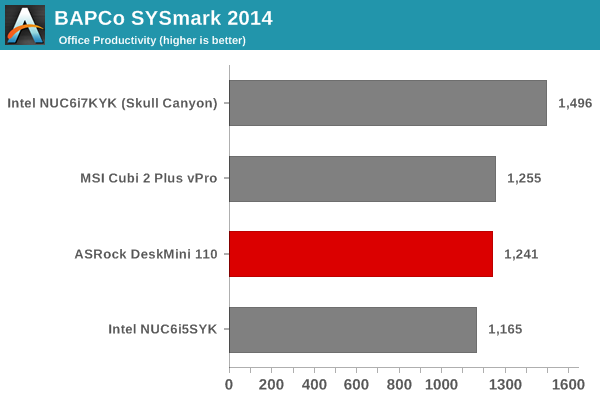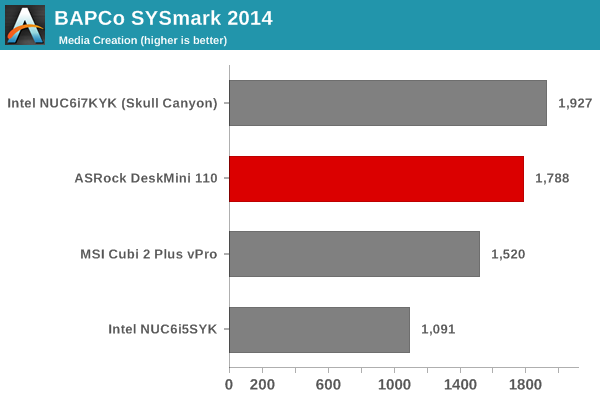ASRock DeskMini 110 mini-STX PC Review
by Ganesh T S on June 8, 2016 8:45 AM ESTPerformance Metrics - I
The ASRock DeskMini 110 was evaluated using our standard test suite for small form-factor PCs. Not all benchmarks were processed on all the machines due to updates in our testing procedures. Therefore, the list of PCs in each graph might not be the same. In the first section, we will be looking at SYSmark 2014, as well as some of the Futuremark benchmarks.
BAPCo SYSmark 2014
BAPCo's SYSmark 2014 is an application-based benchmark that uses real-world applications to replay usage patterns of business users in the areas of office productivity, media creation and data/financial analysis. Scores are meant to be compared against a reference desktop (HP ProDesk 600 G1 with a Core i3-4130, 4GB RAM and a 500GB hard drive) that scores 1000 in each of the scenarios. A score of, say, 2000, would imply that the system under test is twice as fast as the reference system.




SYSmark scores are heavily dependent on the CPU in the system. Here, we see the 65W TDP Core i5-6500 come behind the 45W TDP Core i7-6770HQ, primarily due to the hyperthreading (4C/8T) features of the latter. Note that the Core i5-6500 is a 4C/4T CPU. Other than that, the DeskMini that we built has no trouble proving to be better at business workloads compared to systems equipped with lower TDP CPUs.
Futuremark PCMark 8
PCMark 8 provides various usage scenarios (home, creative and work) and offers ways to benchmark both baseline (CPU-only) as well as OpenCL accelerated (CPU + GPU) performance. We benchmarked select PCs for the OpenCL accelerated performance in all three usage scenarios. These scores are heavily influenced by the CPU in the system. The aspects noted in the SYSmark 2014 subsection apply here too. The DeskMini comes second to Skull Canyon, but has no trouble being better than the other systems in the comparison list.



Miscellaneous Futuremark Benchmarks





The 3D benchmarks present a different story, because the HD Graphics 530 is not as powerful as the GPUs in either Skull Canyon (Iris Pro with eDRAM) or even the U-series models for many workloads.
3D Rendering - CINEBENCH R15
We have moved on from R11.5 to R15 for 3D rendering evaluation. CINEBENCH R15 provides three benchmark modes - OpenGL, single threaded and multi-threaded. Evaluation of select PCs in all three modes provided us the following results. The Core i5-6500's single threaded performance is top of the line, thanks to the high TDP / clock speed. However, absence of hyperthreading allows Skull Canyon (Core i7-6770HQ) to sneak ahead in the multi-threaded case. The OpenGL results lend further credence to the analysis of the GPU capabilities made in the previous subsection.













85 Comments
View All Comments
aethertron - Sunday, June 12, 2016 - link
I'm new to this, does the i5 HQ version draw the same power and get the same clock as the 65 W desktop version? I was thinking of this form factor because I was hoping to put full-power desktop components in a smaller form factor.extide - Monday, June 13, 2016 - link
That IS a full power normal desktop CPU, like you can buy at newegg.Gadgety - Wednesday, June 8, 2016 - link
@TS Ganesh " larger than the NUCs, but smaller than a mini-ITX build"Why do you not list case dimensions in the specifications as this is part of the point of evaluating this offering?
t.s - Wednesday, June 8, 2016 - link
seconded. A review about SFF, without the dimension is quit funny.ganeshts - Wednesday, June 8, 2016 - link
Approx. 6.125" x 6.125" x 3.125" by rough measurements. That comes to ~1.9L, but ASRock claims 1.82L in their press release. I might be off by 0.1" or so in the hurried measurements that I took.Btw, you can get an idea of how small the case is from the photo here: http://www.asrock.com/news/index.us.asp?id=3303
Gadgety - Wednesday, June 8, 2016 - link
Thank you.fanofanand - Wednesday, June 8, 2016 - link
Thank you Ganesh, I am awful at visualizing dimensions, that picture changes my entire opinion of this device. I went from simply being bummed about the PCI-e being at 2.0 speeds to being stoked at the possibilities. I am still holding out hope for a usable (FB, Youtube etc.) USB stick PC, but I may give up waiting (will likely be years for that to be realized) and just go for something like this. Great article Ganesh!QChronoD - Wednesday, June 8, 2016 - link
I was expecting to see a picture of this next to a modular PSU with the caption of "Can you guess which is which?"Michael Bay - Saturday, June 11, 2016 - link
Same here, looks just like a fancy PSU would.Eden-K121D - Wednesday, June 8, 2016 - link
Where is the GTX 1080 review ?